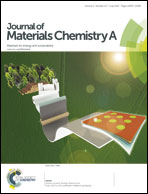Metal organic framework-derived Fe/C nanocubes toward efficient microwave absorption†
Abstract
Composites of magnetic metal nanoparticles and carbon materials are highly desirable for high-performance microwave absorbers due to their compatible dielectric loss and magnetic loss abilities. In this article, novel nanocomposites, Fe/C nanocubes, have been successfully prepared through an in situ route from a metal–organic framework, Prussian blue, by controlled high-temperature pyrolysis. The resultant nanocubes are actually composed of a cubic framework of amorphous carbon and uniformly dispersed core–shell Fe@graphitic carbon nanoparticles. Within the studied pyrolysis temperature range (600–700 °C), the porous structure, iron content, magnetic properties, and graphitization degree of the Fe/C nanocubes can be well modulated. Particularly, the improved carbon graphitization degree, both in amorphous frameworks and graphitic shells, results in enhanced complex permittivity and dielectric loss properties. The homogeneous chemical composition and microstructure stimulate the formation of multiple dielectric resonances by regularizing various polarizations. The synergistic effect of dielectric loss, magnetic loss, matched impedance, and dielectric resonances accounts for the improved microwave absorption properties of the Fe/C nanocubes. The absorption bands of the optimum one obtained at 650 °C are superior to most composites ever reported. By considering the good chemical homogeneity and microwave absorption, we believe that the as-fabricated Fe/C nanocubes will be promising candidates as highly effective microwave absorbers.


 Please wait while we load your content...
Please wait while we load your content...